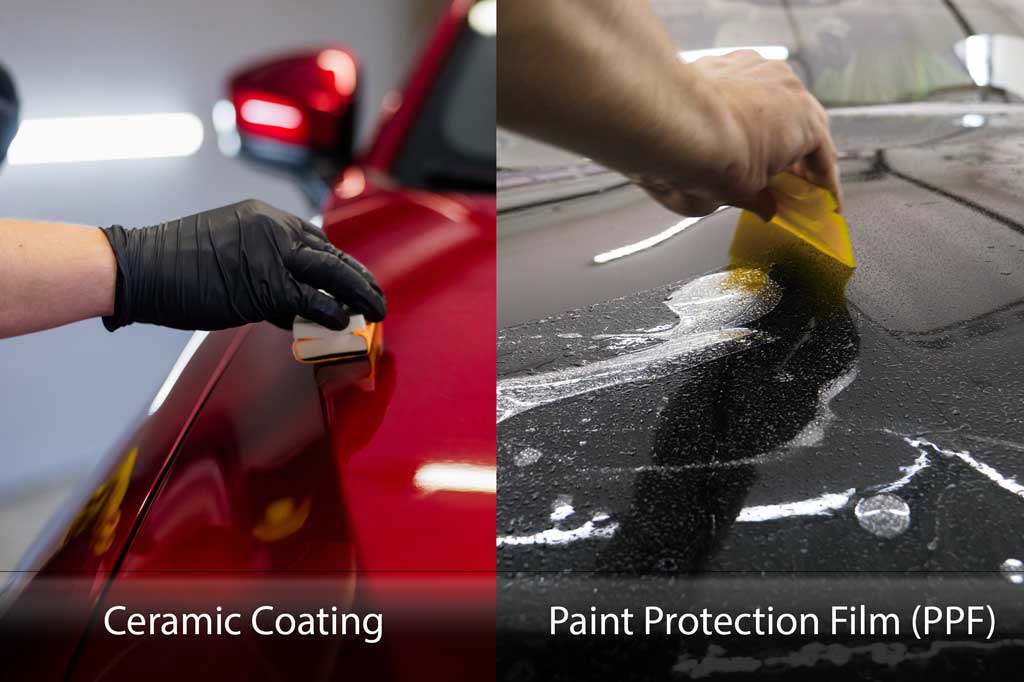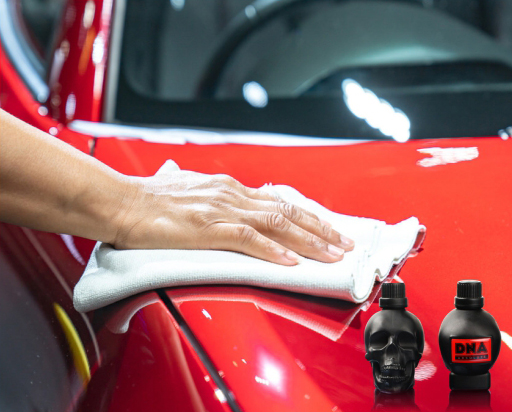The Function of Ceramic Layer in Safeguarding Your Automobile's Paint From Environmental Damages
Ceramic coating has emerged as an advanced option for cars and truck proprietors seeking to maintain the stability of their automobile's outside. As we discover the subtleties of ceramic finishing, it comes to be obvious that the choice to implement this safety procedure might substantially influence your car's durability and aesthetic.
What Is Ceramic Covering?
Ceramic finish is an advanced liquid polymer applied to the external surface areas of an automobile, made to offer a long lasting layer of protection for the paint. This ingenious remedy forms a chemical bond with the vehicle's factory paint, developing a hydrophobic and durable guard. The finish contains nanoparticles that complete the microscopic blemishes in the paint, causing a smooth surface area that boosts gloss and beam.
Usually, ceramic layers are offered in different formulations, enabling various degrees of protection and long life. While some items can last for a number of months, others offer security for a number of years, relying on the thickness of the application and ecological variables. The application procedure requires thorough preparation, including cleaning, decontaminating, and polishing the car's surface area to ensure ideal adhesion of the layer.

Benefits of Ceramic Covering
Among the main advantages of applying a ceramic layer is the extraordinary defense it provides to automobile paint. This innovative finishing forms a durable layer that guards the vehicle's surface from a range of ecological hazards, consisting of UV rays, acid rainfall, bird droppings, and tree sap. By giving this robust defense, ceramic coatings substantially minimize the threat of fading and etching, protecting the automobile's aesthetic appeal gradually.
In addition to defense, ceramic coverings are renowned for their hydrophobic residential or commercial properties, which push back water and dirt, making it much easier to preserve a tidy car. This self-cleaning effect decreases the regularity of cleaning, conserving both time and resources. Ceramic layers improve the deepness of the paint's gloss, resulting in a vivid and refined appearance that boosts the overall look of the automobile.
An additional noteworthy advantage is the longevity of ceramic finishings. Unlike standard waxes or sealers that call for regular reapplication, ceramic coatings can last numerous years, supplying a cost-effective solution for car proprietors seeking long-lasting protection. In general, investing in ceramic covering causes improved longevity, minimized maintenance, and continual aesthetic appeal for vehicle paint.
Just How Ceramic Coating Works
A ceramic covering runs through a chemical bonding procedure that produces a safety layer on the car's paint surface. This ingenious remedy makes use of innovative nanotechnology, where tiny fragments of silica are put on hold in a liquid kind - ceramic coating. Upon application, these bits bond with the factory paint, developing a hydrophobic and resilient layer that boosts the vehicle's surface area
The major element of ceramic coatings, silicon dioxide (SiO2), contributes to the finishing's toughness and resilience. When cured, the finishing transforms right into a tough, glass-like finish that guards the paint from environmental pollutants such as dust, UV rays, bird droppings, and informative post tree sap. This molecular bond results in a surface that is not just resistant to scrapes yet additionally much easier to clean, as dust and gunk are less likely to stick.
In addition, the hydrophobic residential properties of ceramic finishes trigger water to grain and slide off, decreasing the possibilities of water areas and natural resource. This safety obstacle effectively prolongs the life of the paint and keeps the vehicle's aesthetic appeal, using automobile owners a resilient solution for paint defense.
Application Refine of Ceramic Finish
When considering the Visit This Link application of ceramic coating, prep work is essential to achieving optimum outcomes. The primary step entails extensively washing the vehicle to eliminate dust, gunk, and impurities from the surface. This usually consists of a purification procedure using clay bars or chemical cleansers to guarantee the paint is flawlessly tidy. Any scrapes or flaws ought to be addressed at this phase, as the finish will certainly bond with the surface beneath.

Ceramic covering is after that used in small areas, commonly utilizing an applicator pad. The vehicle must be left to cure in a regulated setting to allow the finish to fully bond with the paint.
Long-Term Maintenance and Care
Achieving an effective ceramic finish application sets the structure for long-term defense, but correct upkeep is important to preserving its go right here benefits. Normal washing is crucial; using a pH-neutral auto shampoo will certainly assist maintain the layer's stability without creating damages. Avoid automated vehicle washes that usage unpleasant materials, as they can jeopardize the finish's surface.

Moreover, applying a ceramic layer maintenance spray can boost the existing layer, offering an added boost in security and shine. It's a good idea to perform this every 3 to 6 months, relying on ecological direct exposure.
Last but not least, car parking in shaded areas or utilizing automobile covers can prevent prolonged direct exposure to unsafe UV rays and environmental pollutants, additionally extending the life of your ceramic finishing. By sticking to these maintenance methods, you can ensure your automobile's finish continues to be safeguarded and aesthetically appealing for years ahead.
Conclusion
In recap, ceramic finish functions as an essential safety measure for automotive paint, successfully shielding vehicles from a series of ecological hazards. Its ability to create a durable hydrophobic obstacle not only enhances visual allure yet likewise substantially minimizes the regularity and strength of maintenance called for. The long-lasting nature of this innovative polymer emphasizes its value in maintaining automobile honesty and look, inevitably adding to a much more sturdy and visually attractive auto surface.
Ceramic layer is a sophisticated fluid polymer applied to the exterior surface areas of an automobile, developed to supply a durable layer of defense for the paint. Ceramic layers enhance the deepness of the paint's gloss, resulting in a sleek and lively appearance that boosts the general appearance of the vehicle.
A ceramic layer operates through a chemical bonding procedure that creates a safety layer on the automobile's paint surface area.The primary part of ceramic finishings, silicon dioxide (SiO2), adds to the layer's toughness and strength.In summary, ceramic coating serves as a vital protective action for automobile paint, effectively shielding vehicles from a range of environmental dangers.